소더비, 피카소 작 마리-테레즈 월터 모델 '누워있는 나부' 경매 6천만 달러 예상
Pablo Picasso’s Rapturous 1932 Homage to Marie-Thérèse Walter To Make Auction Debut at Sotheby’s Modern Evening Auction This May
Femme nue couchée A Monumental Achievement in Picasso’s Oeuvre and the History of Portraiture, Is Poised to Achieve in Excess of $60 Million
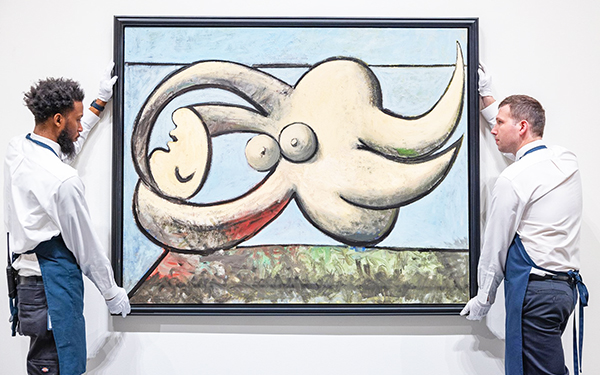
NEW YORK, 7 April 2022 – Painted in April 1932, 90 years ago to the month, Femme nue couchée is one of Pablo Picasso’s most monumental and uninhibitedly sensual portrayals of Marie-Thérèse Walter. Appearing at auction for the first time, the large-scale painting is poised to achieve in excess of $60 million at Sotheby’s Modern Evening Auction on 17 May, making it one of the most valuable portraits of Marie-Thérèse Walter ever offered at auction.
Marie-Thérèse was the inspiration for many of Picasso’s greatest works, with 1932 - the year in which he was finally able to give full painterly voice to his passion - widely regarded as his ‘annus mirabilis’. So extraordinarily was Picasso’s output that year, an entire museum exhibition has been dedicated to it (“Paris 1932”, at Tate Modern in 2018). And while the works from this moment stand out for their creativity and their joyous mood, what perhaps marks them out most of all is the intensity of desire that underpins them. (In fact, the French leg of exhibition at the Musee Picasso was called “Paris 1932: année erotique”).
But of the many portraits Picasso painted of Marie-Thérèse in that year, this particular image stands out: it is a uniquely compelling composition that is radically different, both from anything else in his oeuvre, and from the broader art historical tradition of the female reclining nude. In this work, Picasso evokes Marie-Thérèse with the strong and sensuous fin-like limbs of a sea-creature. Though he would go on to render subsequent lovers in animalistic form, the allusion to the sea here is significant: Marie-Thérèse was also an avid and accomplished swimmer whose powerful, athletic grace in the water was a source of constant fascination for Picasso (something that was perhaps all the more beguiling for him, given that – for all the time he spent on the beach as a child and subsequently – he in fact he never learned to swim). In addition to which, the headiest days of their blossoming relationship were spent by the sea: in the summer of 1928, Picasso took his then-wife Olga and son Paulo to the seaside at Dinard. Unbeknown to them, he also installed his then-still-secret-lover Marie-Thérèse in a holiday camp nearby, ‘eloping’, whenever possible for secret romantic encounters by the sea.
Furthermore, a lover of the sea (‘I am a child of the sea; I long to bathe in it, to gulp down the salty water’) and an avid film goer, Picasso may well have been influenced in this composition by Jean Painlevé’s 1928 surrealist masterpiece, La Pieuvre, “a captivating love letter to one of nature's most intelligent and enigmatic creations.”
Building on the lineage of the reclining nude in art history, Picasso’s Femme nue couchée offers a daring new take on the tradition, upending naturalism for the biomorphic forms of Surrealism and a curvilinear approach derived from his simultaneous sculptural practice, which would prove highly influential to generations of artists to come.
“As one of the star highlights of Tate Modern’s world-class exhibition devoted to 1932 as a pivotal year for Picasso, Femme nue couchée is a ground-breaking, extraordinarily sensual work that remained within the artist’s estate for decades before its acquisition directly from the family of the artist . Marking the first time this painting will appear at auction, our Modern Evening Sale will be a defining moment in solidifying 1932 as one of Picasso’s most critically important and sought-after periods.”
Helena Newman, Sotheby’s Worldwide Head of Impressionist & Modern Art
“There were many notable years in the long, dramatic career of Pablo Picasso, but 1932 stands out as particularly momentous. In this ‘year of wonders,’ Picasso produced some of his most iconic images of Marie-Thérèse, and here she is presented with a potent mix of sensuality and youthful naivety that heralds a major creative turning point for Picasso. As Picasso remains at the pinnacle of the art market, his portraits of Marie-Thérèse are the most desired and defining works of his entire oeuvre, and Femme nue couchée is one of the most exceptional to ever come to auction.”
Julian Dawes, Sotheby’s Head of Modern Art, Americas
In early 1932 Picasso was planning a major retrospective scheduled for June, and in preparation for the exhibition began his first dedicated series of paintings depicting his muse and mistress Marie-Thérèse Walter in the seclusion of his new country home of Boisgeloup. In Femme nue couchée, which was completed during this period, Picasso charted new territory with his portrait of Marie-Thérèse, not only in his own body of work, but in the history of the nude figure with his depiction of her reclining in a highly abstracted space, highlighting her biomorphic figure with touches of fertility, sexuality, and grace. As a landmark work within Picasso’s oeuvre and his famed series completed in 1932, as well as a pivotal example in the history of portraiture, Femme nue couchée’s arrival at auction for the first time this Spring marks a significant moment in Picasso’s unrivaled legacy in the art market.
The story of Picasso’s first encounter with Marie-Thérèse, and their subsequent love affair, is among the most compelling in 20th century art history. Picasso first met Marie-Thérèse in Paris in 1927 when she was seventeen years old. The couple’s relationship was kept a well-guarded secret for many years, both on account of the fact that Picasso was then still married to Olga Khokhlova, a Russian-Ukrainian dancer he had met on tour with Diaghilev, and because of Marie-Thérèse’s age. It was during these preceding months that he first cast his artistic spotlight on the voluptuous blonde. Until then, Picasso had only referenced his extramarital affair with Marie-Thérèse in code, sometimes embedding her symbolically in a composition or rendering her unmistakable profile as a feature of the background. But by the end of 1931, Picasso could no longer repress the creative impulse that his lover inspired, and over Christmas 1931 and into early 1932, Marie- Thérèse emerged, for the first time, in fully recognizable, languorous, form in his work.
For Picasso, Marie-Thérèse offered a sensual amalgam of the lover, the model, and the goddess, and would be cast in many roles throughout his body of work. In Boisgeloup, Picasso increasingly devoted his time and creative energy to sculpture, including a number of plaster busts and reclining nude portraits of Marie-Thérèse. The influence of this medium is visible in Femme nue couchée in the monumental sculptural force with which Picasso portrays the female body. At the same time, the psychological state of the sleeping woman resonates in the soft modelling of the figure, creating an atmosphere of reverie and carefree abandon. Seeking to convey his erotic desire, Picasso generates morphological permutations and distortions of the female anatomy. Abandoning any attempt at naturalism, he creates a figure composed of biomorphic forms, a technique that developed from his earlier, Surrealist works.
Picasso’s treatment of the female figure is undoubtedly rooted in the great tradition of the reclining nude in art history, following his predecessors Goya, Ingres, and Manet, among others. Yet, the artist’s shocking new take on the nude and frank sexuality would provide an influence to some of the greatest artists in the generations to follow.
파블로 피카소와 일곱 뮤즈들 <4>
#4 초현실주의 시대: 마리-테레즈 월터(1927-1940)
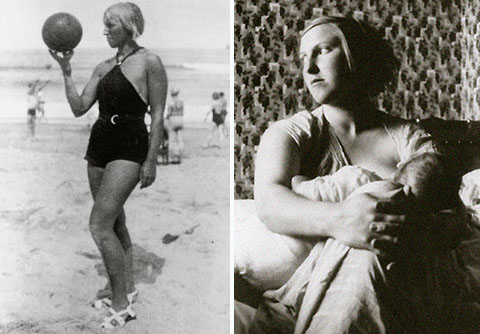
Marie-Thérèse Walter, 1929/ 1936
"넌 참 흥미로운 얼굴을 가졌어. 너를 그리고 싶어. 나는 피카소야."
1927년 1월, 45세의 유부남 피카소와 17세의 소녀 마리-테레즈 월터(Marie-Thérèse Walter, 1909-1977)는 파리의 백화점 갤러리 라파예트에서 만났다. 수영으로 다진 몸매에 뚜렷한 윤곽, 코발트블루의 눈빛과 금발의 마리-테레즈는 피카소가 끊임없이 왜곡하는 초현실주의 시대의 뮤즈가 된다.
마리-테레즈는 피카소와 올가의 집 길 건너편에 아트딜러 폴 로젠버그가 마련해준 아파트에서 살며 은밀한 관계를 유지했다. 피카소는 1930년 프랑스 북서부 노르망디의 부아겔루프의 성채를 구입해 조각 작업실로 사용하면서 새 뮤즈 마리-테레즈를 불러들었다. 노르망디는 피카소가 부인 몰래 마리-테레즈와 바람을 피울 수 있는 지상의 낙원이었다. 마리-테레즈는 피카소에게 수영을 가르쳐주었다.
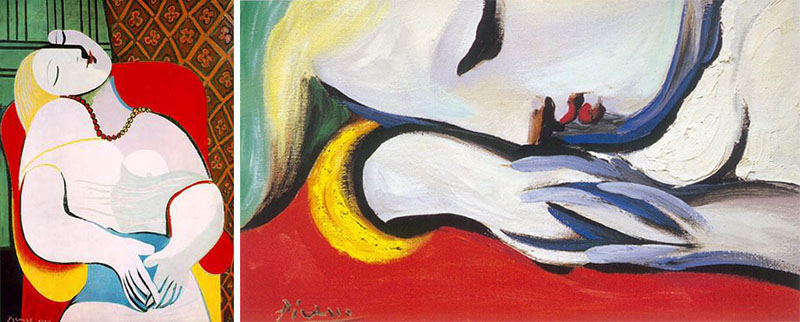
Pablo Picasso, Le Rêve, 1932/ Rest, 1932
마리-테레즈와의 연애시절 피카소의 그림은 밝고 화사했다. 마리가 금발로 등장하는 '꿈'(Le Rêve, 1932)은 1997년 소더비에서 4천840만 달러에 팔리며 경매 사상 네번째 비싼 회화를 기록했다. 이 그림은 2013년 프라이빗 세일에서 헤지펀드 매니저 스티브 A. 코헨이 1억5천500만 달러에 구입했다.
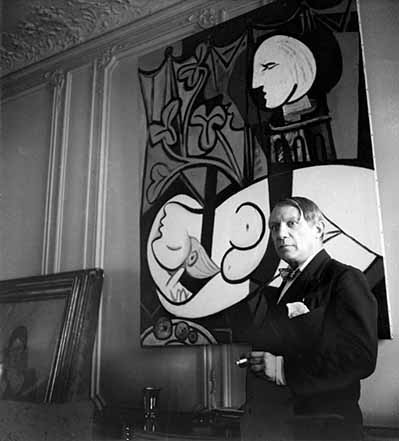
Pablo Picasso, Nude, Green Leaves and Bust, 1932/ Picasso by Cecil Beaton, 1933
2010년 마리-테레즈를 모델로 그린 '누드, 녹색잎, 흉상, 1932)'가 크리스티에서 1억650만 달러에 팔렸다. 런던의 테이트 모던은 피카소의 창작열이 가장 왕성했던 1932년의 작품 100여점을 모은 'Picasso 1932–Love, Fame, Tragedy'를 열었다.
1935년 마리-테레즈가 임신하자 올가의 친구가 일러 바쳤다. 8년 동안의 불륜을 그제서야 깨달은 올가는 일단 아들 파올로를 데리고 남부 프랑스로 이주했다. 그리고, 이혼소송에 들어갔다. 하지만, 피카소는 이혼해주지 않았다. 프랑스의 이혼법은 재산의 절반을 부인에게 주어야했기 때문이다. 올가는 이후 20년간 피카소와 별거하며 법적 부인으로 남았다. 그리고, 1955년 칸에서 눈을 감았다.
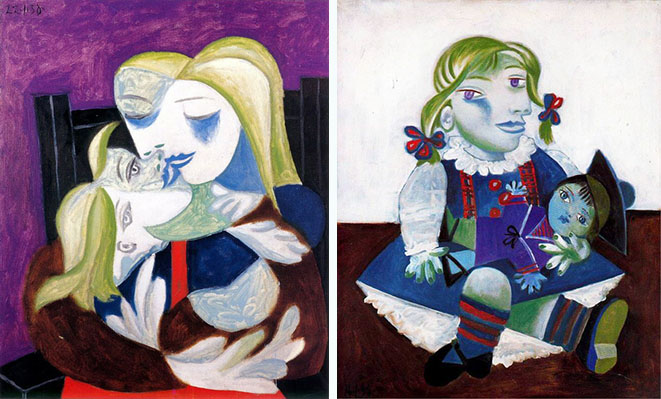
Pablo Picasso, Woman and Child, 1938/ Maya with a Doll, 1938
한편, 마리-테레즈는 1935년 9월 딸 마야(Maya Widmaier-Picasso)를 출산했다. 1895년 피카소가 13살 때 여동생 콘치타가 디프테리아로 사망했다. 금발의 콘치타는 겨우 7살이었다. 아마도 마리-테레즈는 여동생을 연상시켰는지도 모른다. 피카소는 마야에게 여동생 이름을 따서 'Maria de la Concepcion'라고 지어주었고, 마야(Maya)라고 불렀다. 마리-테레즈와 마야는 피카소와 남부 프랑스에서 살다가 베르사이유 인근에 정착했다. 피카소는 주말에 방문해 모녀를 모델로 그리기도 했다.
피카소의 바람끼는 마리-테레즈가 임신했을 때 다시 발동했다. 1935년 마리-테레즈가 예고없이 피카소의 작업실을 방문했을 때 초현실주의 사진가 도라 마르(Dora Maar)가 있었다. 두 여인은 피카소에게 둘 중 하나를 선택하라고 요구했고, 피카소는 둘이 싸워서 결정하라고 응수했다. 그러자 두 여인은 몸싸움까지 벌인 것으로 알려졌다.
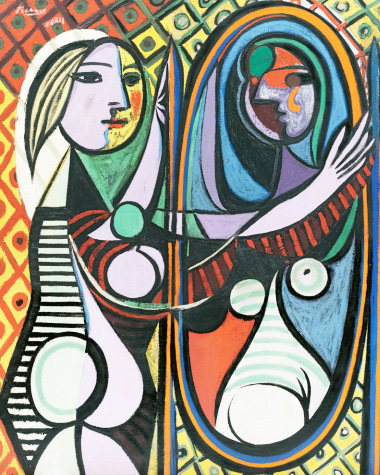
Pablo Picasso, Girl before a Mirror, 1932. MoMA Collection
1940년 마리-테레즈는 피카소와 결별하고, 마야와 파리로 이주했다. 피카소는 양육비와 재정지원을 해주었지만, 결혼은 하지 않았다. 올가와 법적으로 부부 관계였기 때문이기도 하다. 1977년 10월, 피카소가 사망한 지 4년 후 마리 테레즈는 남프랑스의 주앙레빵에서 자살했다.
마리-테레즈의 딸 마야는 아버지 피카소 작품 연구와 보존에 헌신했다. 마야의 아들 올리비에 위드마이어 피카소는 할아버지 전기 'Picasso: The Real Family Story'를 출간했고, 손녀 다이애나 위드마이어 피카소는 큐레이터로 피카소의 조각 카탈로그를 집필했다. 2011년 뉴욕 가고시안 갤러리에서 'Picasso and Marie-Thérèse: L’Amour Fou', 2017년 파리 가고시안 갤러리에선 'Picasso and Maya: Father and Daughter' 전시가 열렸다. 두 전시의 큐레이터는 손녀 다이애나 위드마이어 피카소였다.
http://www.nyculturebeat.com/index.php?mid=Art2&document_srl=3946254




 재즈 뮤지션 델로니어스 몽크 버추얼 무료 토론회(4/11, 타운홀)
재즈 뮤지션 델로니어스 몽크 버추얼 무료 토론회(4/11, 타운홀)
 구겐하임뮤지엄 칠레 작가 세실리아 비쿠냐(Cecilia Vicuña) 개인...
구겐하임뮤지엄 칠레 작가 세실리아 비쿠냐(Cecilia Vicuña) 개인...

